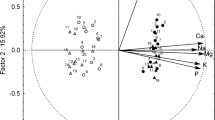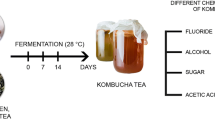Abstract
The study aimed to determine the content of selected elements: sodium, potassium, copper, zinc, iron, manganese and active ingredients such as phenolic acids and tannins in teas containing Yerba Mate and Rooibos cultivated in various areas. The study material comprised six samples of Yerba Mate teas and of Rooibos teas, both tea bags and leaves, purchased in Puławy and online via Allegro. In total, 24 samples were tested. Yerba Mate was particularly abundant in Mn and Fe. The richest source of these elements was Yerba Mate Yer-Vita (2261.3 mg · kg−1 d.m.) and (691.6 mg · kg−1 d.m.). The highest content of zinc was determined in Yerba Mate Amanda with lime (106.0 mg · kg−1 d.m.), while copper was most abundant in Yerba Mate Big-Active cocoa and vanilla (14.05 mg · kg−1 d.m.). In Rooibos, the content of sodium was several times higher than in Yerba Mate. A clear difference was observed in the content of minerals in dry weight of the examined products, which could be a result of both the taxonomic distinctness and the origin of the raw material. Leaf teas turned out to be a better source of tannins; on the other hand, tea bags contained substantially more phenolic acids. The richest source of phenolic acids was Yer-Vita in bags (1.8 %), and the highest amount of tannins was recorded in the leaf tea Green Goucho caramel and dark chocolate (9.04 g · 100 g−1 d.m.). In Rooibos products, the highest content of phenolic acids was recorded in tea bags (Savannah with honey and vanilla 0.96 %), and tannins in (Lord Nelson with strawberry and cream 7.99 g · 100 g −1 d.m.).
Similar content being viewed by others
References
Malik J, Szakova J, Drabek O, Balik J, Kokoska L (2008) Determination of certain micro and macroelements in plant stimulants and their infusions. Food Chem 111:520–525
Dmowski P, Śmiechowska M, Deja B (2011) Influence of the tea brewing conditions on the content of tannins and choosen parameters of colour. Zesz AM Gdynia 68:5–12
Kruszewski B, Jakóbiak A, Jasiczek A, Wieczorek B, Niemczuk D (2012) Influence of brewing parameters on caffeine content in Yerba Mate infusions. Bromatol Chem Toksykol 45:1001–1005
Joubert E, Gelderblom WCA, Louw A, De Beer C (2008) South African herbal teas: Aspalathus linearis, Cyclopia spp. and Athrixia phylicoides—a review. J Ethnopharmacol 119:376–412
Gawlik-Dziki U (2004) Phenolic acids as bioactive compounds in food products. Żywność Nauka Technika Jakość 4:29–40
Budryn G, Nebesny E (2006) Phenolic acids—their properties, occurrence in plant materials, absorption and metabolism. Bromatol Chem Toksykol 34(2):103–110
Kudełka W, Kosowska A (2008) Components of spices and herbs determining their functional properties and their role in human nutrition and prevention of diseases. Zesz Nauk UEK 781:83–111
Florczak J, Karmańska A, Wędzisz A, Brożek E (2011) Chemical content of various dried Yerba Mate leaves. Bromatol Chem Toksykol 44:1105–1110
Negrusz-Kawecka M (2004) The role of sodium in the pathogenesis of primary hypertension. Adv Clin Exp Med 13:101–107
Jarosz M, Bułhak-Jachymczyk B (2008) Human nutrition standards. Grounds for preventing obesity and non-contagious diseases. PZWL, Warsaw
Czech A, Rusinek E, Dariusz Bartoszek D (2006) The trace elements content in the selected vegetables from the Lublin area. Rocz Panstw Zakl Hig 57:57–64
Pasternak K (2000) Bioelements in medicinal practice. Akademia Medyczna, Lublin
Błoniarz J, Zaręba S, Rahnama M (2005) Iron and manganese in selected herbs and herbal-fruit teas. Rocz Panstw Zakl Hig 56:179–187
Brewer GJ (2010) Risks of copper and iron toxicity during aging in humans. Chem Res Toxicol 23:319–326
Rusinek E, Ognik K, Sembratowicz I, Truchliński J (2006) Influence of habitat conditions on macroelements and trace elements in selected fruits grown in the Lublin region. J Elementol 11:199–206
Flaten TP (2002) Aluminium in tea—concentrations, speciation and bioavailability. Coord Chem Rev 228:385–395
Sembratowicz I, Rusinek-Prystupa E (2014) Effect of brewing time on the content of minerals in infusions of medicinal herbs. Pol J Environ Stud 24:177–186
Herman K (1991) An outline of atomic absorption spectrometry. Based on ATI UNICAM - atomic absorption spectrometry methods manual. Warsaw
Official Methods of Analysis of AOAC (1995) Internatonal 16th Edition Arlington
Polish Pharmacopeia V (1999) PZWL 5 Warsaw
Cisowski W, Dembińska-Migas W, Gill S, Łuczkiewicz I (1995) Phytochemical analysis. AMG, Gdańsk
Olivier J, Symington EA, Jonker CZ, Rampedi IT, Van Eeden TS (2012) Comparison of the mineral composition of leaves and infusions of traditional and herbal teas. S Afr J Sci 108:623
Sanz MDT, Isasa MET (1991) Elementos minerales em la yerba mate (Ilex paraguariensis St. H.). Arch Latinoam Nutr 41:441–454
Gajewska R, Nabrzyski M, Ganowiak Z, Cybulski M, Kułakowska D (2000) The contents of some minerals in the green and black teas. Rocz Panstw Zakl Hig 51:251–258
Jacques RA, Arruda EJ, De Oliviera LC, De Oliviera AP, Dariva C, De Oliviera JV, Caramăo EB (2007) Influence of agronomic variables on the macronutrient and micronutrient contents and thermal behavior of mate tea leaves (Ilex paraguariensis). J Agric Food Chem 55:7510–7516
Garcia RV, Peralta I, Cabalerro S (2005) Fraction of minerals extracted from Paraguayan Yerba Mate (Ilex Paraguariensis, S.H.) by cold tea (maceration) and hot tea (infusion) as consumed in Paraguay. Rojasiana 7:21–25
Jarosz M (2012) Amended nutrition standards for the population of Poland. IŻŻ, Warsaw
Ziemlański S (2001) Human nutrition standards. Physiological grounds. PZWL, Warsaw
Paz-Rodríguez B, Domínguez-González MR, Aboal-Somoza M, Bermejo-Barrera P (2015) Application of high resolution-continuum source flame atomic absorption spectrometry (HR-CS FAAS): determination of trace elements in tea and tisanes. Food Chem 170:492–500
Cardozo EL, Ferrarese-Filho O, Filho LC, Ferrarese ML, Donaduzzi CM, Sturion JA (2007) Methylxanthines and phenolic compounds in mate (Ilex paraguariensis St. Hil.) progenies grown in Brazil. J Food Compos Anal 20:553–558
Streit NM, Rychecki Hecktheuer LH, Weber do Canto M, Mallmann CA, Streck L, Vey Parodi T, Pedrolo Canterle L (2007) Relation among taste-related compounds (phenolics and caffeine) and sensory profile of erva-mate (Ilex paraguariensis). Food Chem 102:560–564
Rabe C, Steenkamp JA, Joubert E, Burger JFW, Ferreira D (1994) Phenolic metabolites from rooibos tea (Asphalantus linearis). Phytochemistry 34:1559–1565
Ferreira D, Marais C, Steenkamp JA, Joubert E (1995) Rooibos tea as a likely health food supplement. In Proceedings of Recent development of Technologies on Fundamental foods for Health; Korean Society of Food Science and Technology: Seoul, Korea, 73-88
Beelders T, Sigge GO, Joubert E, de Beer D, de Villiers A (2012) Kinetic optimisation of the reversed phase liquid chromatographic separation of rooibos tea (Aspalathus linearis) phenolics on conventional high performance liquid chromatographic instrumentation. J Chromatogr A 1219:128–139
von Gadow A, Joubert E, Hansmann CF (1997) Comparison on the antioxidant activity of aspalathin with that of other plant phenols of Rooibos tea (Aspalathus linearis), α-tocopherol, BHT, and BHA. J Agric Food Chem 45:632–638
Joubert E, Winterton P, Britz TJ, Ferreira D (2004) Superoxide anion and α, α-diphenyl-β-picrylhydrazyl radical scavenging capacity of Rooibos (Aspalathus linearis) aqueous extracts, crude phenolic fractions, tannin and flavonoids. Food Res Int 37:133–138
Morton JF (1983) Rooibos tea, Aspalathus linearis, a caffeine less, low-tannin beverage. Econ Bot 37:164–173
South African Department of Agricultural Technical Services (1976) Communication to manager. Rooibos tea Control Board, Clanwilliam
Stańczyk A, Rogala E, Wędzisz A (2010) Determination of the contents of tannins and selected minerals in green tea. Bromatol Chem Toksykol 43:505–508
Arts IC, van De Putte B, Hollman PC (2000) Catechin contents of foods commonly consumed in The Netherlands. 2. Tea, wine, fruit juices, and chocolate milk. J Agric Food Chem 40:1752–1757
Weber G, Schwedt G (1984) Types of binding of iron, copper, and zinc in various varietes of tea. Z Lebensm Unters Forsch 178:110–114
Yang CS, Hong J, Hou Z, Sang SM (2004) Green tea polyphenols: antioxidative and prooxidative effects. J Nutr 134:3181
Record IR, McInerney JK, Dreosti IE (1996) Black tea, green tea, and tea polyphenols. Effect on trace element status in weanling rats. Biol Trace Elem Res 53:27–43
Street R, Száková J, Drábek O, Mládková L (2006) The status of micronutrients (Cu, Fe, Mn, Zn) in tea and tea infusions in selected samples imported to the Czech Republic. Czech J Food Sci 24:62–71
Szymczycha-Madeja A, Welna M, Pohl P (2014) Simple and fast sample preparation procedure prior to multi-element analysis of slim teas by ICP OES. Food Anal Methods 7(10):2051–2063
Author information
Authors and Affiliations
Corresponding author
Ethics declarations
Ethical Approval
All procedures performed in studies involving human participants were in accordance with the ethical standards of the institutional and with the 1964 Helsinki Declaration and its later amendments or comparable ethical standards.
Conflict of Interest
The authors declare that they have no competing interests.
Rights and permissions
About this article
Cite this article
Rusinek-Prystupa, E., Marzec, Z., Sembratowicz, I. et al. Content of Selected Minerals and Active Ingredients in Teas Containing Yerba Mate and Rooibos. Biol Trace Elem Res 172, 266–275 (2016). https://doi.org/10.1007/s12011-015-0588-9
Received:
Accepted:
Published:
Issue Date:
DOI: https://doi.org/10.1007/s12011-015-0588-9




